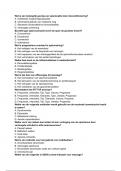Summary
Summary NURS 262 Exam 1 Study Guide
- Course
- NURS 325
- Institution
- Virginia Commonwealth University
This is a comprehensive and detailed study guide on Exam 1 for Nurs 325. *Essential Study material!! *For you,at a price that's fair enough!! Enjoy!!
[Show more]






